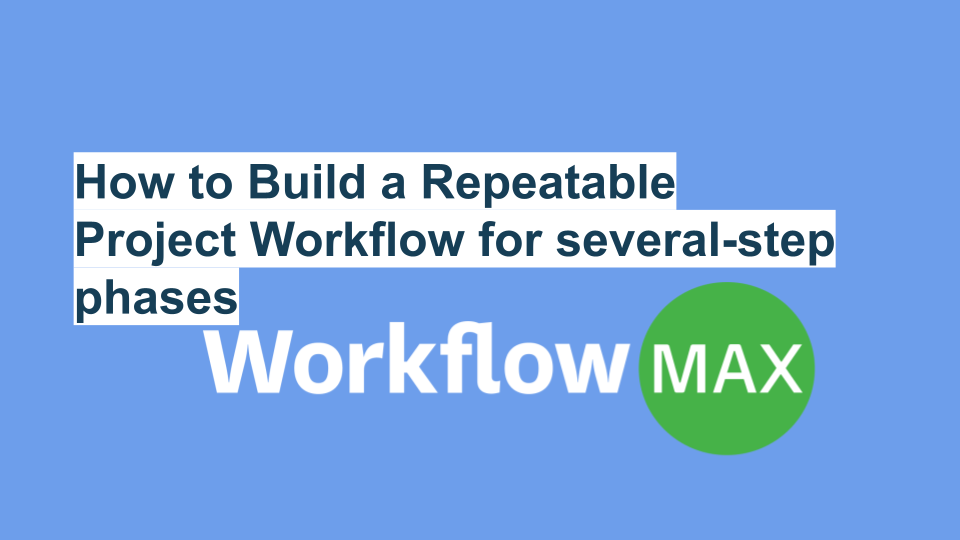TL;DR: Repeatable project workflows create clear, consistent paths that move teams smoothly through multi-step phases. Mapping each step—sequential, parallel, rules-driven, or hybrid—exposes bottlenecks and enables automation. Visual tools (flowcharts, swimlanes) and stakeholder input make processes transparent; regular reviews keep them customer-centred and efficient. Best practices include setting measurable goals, prioritising critical tasks, automating repetitive work, and monitoring key performance indicators (KPIs). With features like custom templates, centralised docs, time tracking, Xero and QuickBooks integrations, WorkflowMax lets studios design, execute, and refine workflows quickly, boosting productivity, revenue capture, and project quality.
Project workflows boost productivity and maintain consistency. They create a clear path that guides your team from start to finish, accounting for every step. Workflows provide repeatable steps that lead to success.
Managing workflows with multiple steps and phases can be a challenging task. It requires good coordination and a thorough understanding of all elements. Without a solid framework, projects can hit bottlenecks and waste time. Structured frameworks deliver quality and standardisation across processes.
Well-designed workflows streamline projects from beginning to end. They ensure efficient task completion, saving time and effort. Our customisable features let you tailor workflows to your specific needs, adding flexibility and adaptability.
Process mapping gives you a visual representation of workflows. It helps teams spot areas for improvement and removes unnecessary steps. Our comprehensive time tracking captures every minute of work, maximising your revenue and ensuring all billable time is recorded.
Good workflows help you consistently achieve goals and optimise each project phase.
Types and phases of workflows
Understanding workflows is crucial for executing projects efficiently. Different types of workflows suit various business needs.
- Sequential Workflows: Follow a step-by-step order where each task depends on the completion of the previous one. They're ideal for structured projects, such as app development and approval processes.
- Parallel Workflows: Allow multiple tasks to operate simultaneously, reducing wait times. They’re great for marketing campaigns where design and content creation co-occur.
- State Machine Workflows: Offer flexibility, allowing tasks to move between states based on conditions or feedback. Useful for tracking bugs and resolving complex customer support cases.
- Rules-Driven Workflows: Trigger tasks based on predefined conditions, automating decisions efficiently. Examples include IT ticket routing and expense approvals.
- Human-Centric vs. System-Centric Workflows: Human-centric workflows need significant employee judgment. System-centric workflows automate routine tasks.
- Digital Workflows: Connect tasks across departments using centralised software, ensuring clear communication.
Phases of project workflows guide your team through data acquisition, processing, exploration, modelling, and interpretation. Sequential steps and systematic mapping are essential for effective project execution.
WorkflowMax’s customisable features let you tailor workflows to your specific needs, enhancing flexibility and adaptability. Centralised document management ensures easy access and collaboration, streamlining these phases and boosting productivity.
Benefits of workflow mapping
Workflow mapping improves cross-team understanding and accountability. It shows processes visually, helping teams grasp the big picture. Everyone sees their roles clearly, which cuts down errors and boosts teamwork.
When you map workflows, you spot inefficiencies and bottlenecks. Finding problem areas helps teams streamline operations and save time. This approach makes automation possible, handling routine tasks automatically and freeing up resources for complex work.
Workflow mapping supports metrics and KPIs. Tracking performance lets businesses evaluate and improve processes continuously. This drives better productivity and results.
Standard workflows ensure business success through consistency. Clear procedures help complete tasks efficiently, delivering reliable and high-quality outcomes. Our job management features consolidate all tasks, making workflows more efficient and reducing administrative work.
Well-designed workflows create ideal conditions for growth. Teams focus on goals, confident in their solid processes. Good workflows push your business forward, keeping every step aligned with your objectives.
Best practices for workflow mapping
When mapping workflows, using clear visual tools can make a big difference. Techniques such as flowcharts, swimlane diagrams, state diagrams, and data flow diagrams help teams understand processes intuitively.
Accurate mapping of current processes is essential. Capture how things are done now, without idealising. This helps identify inefficiencies and areas for improvement. Involving stakeholders ensures that all perspectives are considered, enhancing the workflow's relevance.
Focus on customer-centric approaches. Tailor workflows to meet customer needs, ensuring satisfaction and retention. This approach aligns processes with business objectives.
Minimise inefficiencies by pinpointing bottlenecks and redundancies. Streamline tasks to save time and resources. Automation plays a key role here, taking over repetitive tasks and freeing up human effort for more complex work.
Foster collaboration by encouraging open communication. Utilise centralised tools, such as WorkflowMax’s document management, to keep everyone connected. This ensures that all team members are on the same page and can easily access vital information.
Regularly review and adjust workflows. Monitoring performance helps keep processes efficient and responsive to change. This continuous improvement mindset drives better results over time.
Creating and optimising workflows
Building and refining workflows involves several key steps that help streamline project management. Start by planning with clearly defined objectives. Know what you want to achieve and set measurable goals. This clarity guides every decision in the workflow process.
Accurate mapping of tasks is crucial. Break down each project into individual tasks and logically sequence them. Use visual tools, such as flowcharts, to help your team clearly understand the steps. This visualisation aids in spotting inefficiencies and areas for improvement.
Task prioritisation is essential. Determine which tasks are critical and need immediate attention. Addressing high-priority tasks first ensures that crucial project elements are completed on time.
Automation opportunities should be explored. Identify repetitive tasks that can be automated to save time and reduce errors. WorkflowMax's customisable features allow you to tailor automation to your specific needs, enhancing efficiency.
Gather feedback regularly to optimise workflows. Encourage team members to share insights on what's working and what needs adjustment. This continuous loop of feedback fosters improvement and keeps workflows responsive to change.
Launch workflows with confidence, ensuring everyone understands their roles. Monitor performance using key performance indicators (KPIs), such as task completion rates and error frequency. Regularly assess these metrics to ensure workflows remain effective and aligned with objectives.
Maintaining workflow efficiency
Investing in business process management (BPM) keeps workflows efficient. It involves monitoring and refining processes to adapt to changing business needs. This enhances collaboration, transparency, and the quality of deliverables.
To set up a repeatable workflow, you need:
- Clear objectives. Knowing what you want to achieve guides the entire workflow process, ensuring everyone aligns with the goals.
- Review your workflows regularly to identify opportunities for improvement. Our customisable features let you tailor workflows to fit specific needs. This keeps processes relevant as your business evolves.
- Ask for team feedback to identify what works and what needs adjustment. Regular input helps improve and maintain effective workflows. Track performance with metrics and KPIs to evaluate and refine processes.
Automation streamlines tasks. Identify repetitive actions to automate, saving time and reducing errors. Our comprehensive job management and Xero integration enhance efficiency, letting your team focus on complex tasks.
Book a demo with us!



.png?width=704&name=unnamed%20(6).png)
